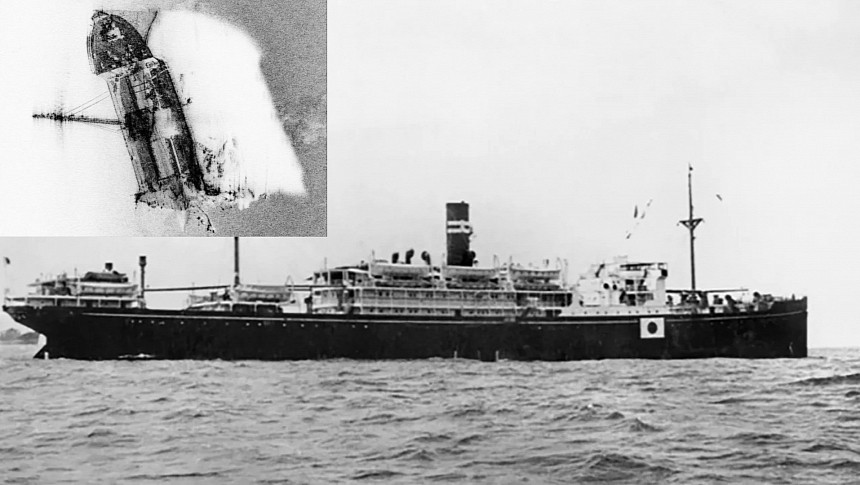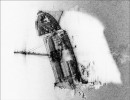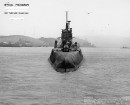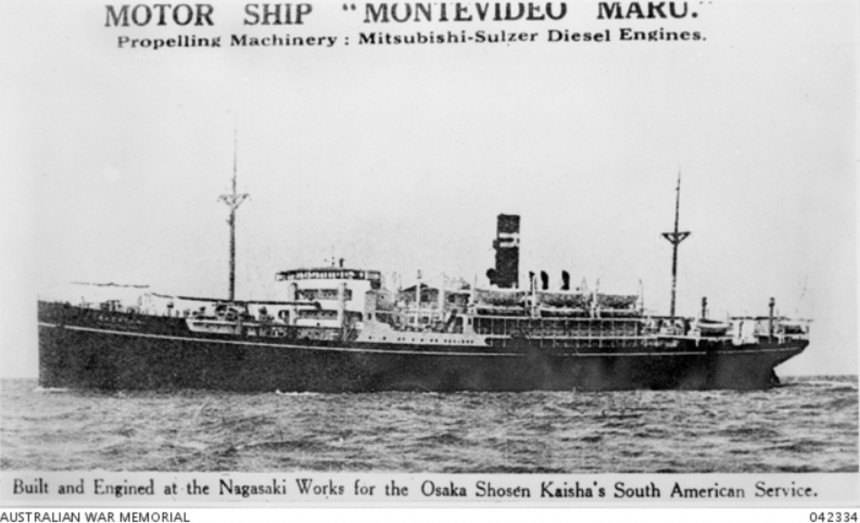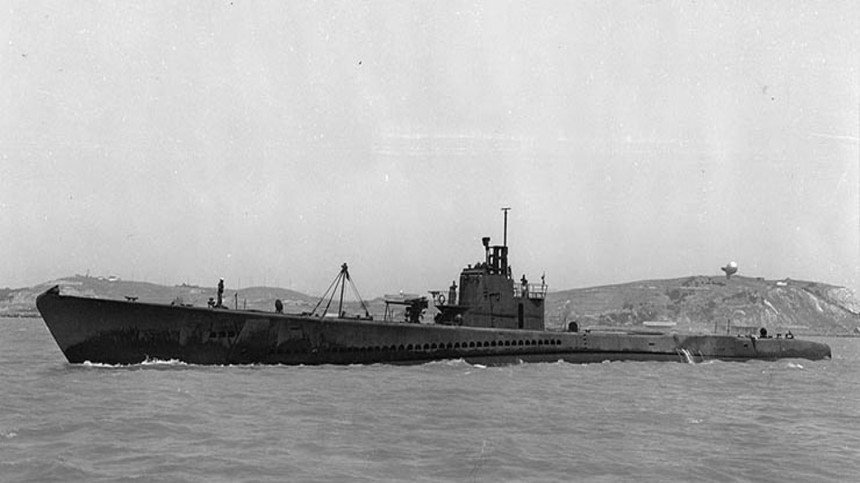Armchair war historians like to think they know all there is to know about the Second World War. They often fancy their knowledge of all things Barbarossa to Berlin and Pearl Harbor to Hiroshima as unparalleled. But sometimes, pieces from the war that so many today never knew existed show up at the bottom of the South China Sea. But the masses really ought to know the story of the Japanese Montevideo Maru, just discovered after over 80 years.
To most people, the Montevideo Maru is a perfectly normal-looking military utility ship, or an auxiliary vessel, as it's called. But to the people of Oceania, specifically the Australians, discovering the Montevideo Maru's wreck is nothing short of finding a sacred burial site. That's because the remains of over a thousand Australian and New Zealand sailors held as POWs lie at the bottom of the sea, entombed in the wreck of this Imperial Japanese warship.
The story of the Montevideo Maru starts hopeful enough. At a time when Japan was still transforming from an isolated pariah state concerned only with its own affairs to one ready and willing to trade with the West in search of status and fortune before promptly going to war with them. Perhaps in no way was this more apparent than with the Imperial Japanese Navy. By the time the mid-1920s rolled around, Imperial Japan had already savaged a significant European power in the form of the Russians during the first Russo-Japanese War.
But lurking on the horizon in Japan during the early to mid-1920s was an impending drive towards expansionism. With resource-rich territory by China, Korea, Mongolia, and the South Pacific in their sights, Imperial Japan would soon attempt its own form of Manifest Destiny. But to do this, they needed ships, a lot more ships. Not just big burly war vessels like aircraft carriers and battleships but also smaller auxiliary vessels to support all the heavy hitters with supplies and sailors.
This was the impetus for the Montevideo Maru's construction when it was laid down on September 9, 1925. It'd take less than 12 months for the 430-foot (130 m) long 7,200-plus ton vessel with a 56-foot (17 m) beam to finish production in Nagasaki for the Osaka Shosen Kaisha (OSK) transportation company. As the third example in the Santos Maru-class motor ship, this class was the first in Japan to ferry passengers internationally to places as far off as North and South America.
Between the trio of ships, the La Plata Maru, the Santos Maru, and the La Plata Maru, engine suppliers from Great Britain, Denmark, and Switzerland, respectively, were contracted to power these world-traveling vessels. The Montevideo Maru specifically received Swiss engines, two Sulzer 6ST60 diesel motors jetting a total of 2,300 hp, and built with the help of the project's primary domestic contractor Mitsubishi Heavy Industries. Had the Japanese attacks on the American Navy base at Pearl Harbor never occurred, this would have been the end of the story for the Montevideo Maru.
The vessel would've spent its days transporting the Japanese diaspora everywhere from China to Brazil and everywhere in between in complete anonymity. But instead, the vessel's first recorded taste of combat came during Imperial Japanese campaigns in modern-day Indonesia in February 1942. In June of that same year, the Montevideo Maru found itself transporting a group of Australian and New Zealand prisoners of war from the recently overrun Australian base on Rabaul in modern-day Papua New Guinea.
Less than four months after the fall of the base, a group of approximately 1,054 Aussie and New Zealand souls were forcibly boarded onto the Montevideo Maru for a journey to the occupied Chinese island of Hainan. At some point during the voyage near the coast of the Philippines, the vessel was spotted just before the horizon by the U.S. Navy Submarine USS Sturgeon on the evening of June 31, 1942. A product of the Mare Island Naval Shipyard just north of San Francisco, California, this Salmon class submarine was armed to the teeth with eight 21-inch (533 mm) torpedo launchers and three 50. caliber deck-mounted machine guns.
Upon sighting the Montevideo Maru, the Sturgeon's Captain William Leslie Wright ordered all four General Motors V16 diesel engines to full steam ahead in pursuit of the Japanese vessel. Though unable to acquire a clear line of fire at first, the USS Sturgeon maintained a path of intercept with the Montevideo Maru as the latter ship maintained a slow but steady cruise to link up with two Imperial Japanese destroyers. Documents from after the incident detailed how LT CMDR Wright and his crew had no idea the Montevideo Maru was carrying allied POWs and even some civilians on board as the USS Sturgeon closed the gap between the two.
The Sturgeon then fired four torpedoes at the Japanese ship's broadside. Though around 100 or so Australian and possibly some New Zealand POWs managed to use parts of the sinking ship as life rafts, it's believed no Allied POWs survived the attack. Among those lost included Tom Vernon Garrett, the grandfather of the lead singer of the Australian rock band Midnight Oil Peter Garret, as well as Harold Page, the brother of Australia's then-Prime Minister Earle Page.
Memoirs from the 20 or so Japanese Navy personnel who survived the singing detailed how the POWs apparently sang the Scots-language folk song "Auld Lang Syne" as their comrades who hadn't made it off the ship sank beneath the waves. It wasn't just Australian and New Zealand POWs who were lost in the sinking of Montevideo Maru; approximately 35 men from the Norweigan vessel MV Herstein whose ship was destroyed back in Rabaul, were also aboard when the Japanese ship went under. None survived.
Several memorials and monuments commemorating the lives of Australians lost in defense of Rabaul and the sinking of the Montevideo Maru were built across Australia, including one inside the Australian Ex-Prisoners of War Memorial in Ballarat, Victoria. And so, the remains of the Montevideo Maru and all the people still on board sat 4,000 meters (13,000 ft) below the waves of the South China Sea. Roughly 80 years, nine months, and 17 days after the events of that fateful day, on April 18, 2023, Australia's Deputy Prime Minister Richard Marles announced a search party consisting partly of Australian military personnel had located the wreck close to the coast of Luzon, the largest and most populous island in the Philippines.
Being one of the most eulogized war graves in the history of Oceania, it was announced soon afterward that the wreck site would not be disturbed for the foreseeable future. So unlike the Titanic or many other famous rediscovered shipwrecks, there won't be opportunities to observe the wreck site and better understand what happened that day. Though if you asked most people, they're liable to say that's the right move considering the sheer weight of the tragedy which unfolded that fateful morning.
As astonishing a discovery as this sacred wreck may be, the Montevideo Maru is just one of over 3,800 Allied and Axis ships lost in the Pacific Theater during World War II. Among this very long list of lost vessels, the final resting place of many of them is still completely unknown. How many more untold stories of abject horror, incredible bravery, and general wartime heroics are still lurking beneath the surface of the Pacific Ocean?
Because we know far more about the surface of the Moon than we do about what's deep beneath Earth's ocean, it's likely an unfortunate percentage of these war vessels will remain undiscovered forever. But on this day in April 2023, humanity was able to check another icon of the Pacific Theater off the list. For that reason, we owe the team who finally found the Montevideo Maru our deepest thanks.
The story of the Montevideo Maru starts hopeful enough. At a time when Japan was still transforming from an isolated pariah state concerned only with its own affairs to one ready and willing to trade with the West in search of status and fortune before promptly going to war with them. Perhaps in no way was this more apparent than with the Imperial Japanese Navy. By the time the mid-1920s rolled around, Imperial Japan had already savaged a significant European power in the form of the Russians during the first Russo-Japanese War.
But lurking on the horizon in Japan during the early to mid-1920s was an impending drive towards expansionism. With resource-rich territory by China, Korea, Mongolia, and the South Pacific in their sights, Imperial Japan would soon attempt its own form of Manifest Destiny. But to do this, they needed ships, a lot more ships. Not just big burly war vessels like aircraft carriers and battleships but also smaller auxiliary vessels to support all the heavy hitters with supplies and sailors.
This was the impetus for the Montevideo Maru's construction when it was laid down on September 9, 1925. It'd take less than 12 months for the 430-foot (130 m) long 7,200-plus ton vessel with a 56-foot (17 m) beam to finish production in Nagasaki for the Osaka Shosen Kaisha (OSK) transportation company. As the third example in the Santos Maru-class motor ship, this class was the first in Japan to ferry passengers internationally to places as far off as North and South America.
The vessel would've spent its days transporting the Japanese diaspora everywhere from China to Brazil and everywhere in between in complete anonymity. But instead, the vessel's first recorded taste of combat came during Imperial Japanese campaigns in modern-day Indonesia in February 1942. In June of that same year, the Montevideo Maru found itself transporting a group of Australian and New Zealand prisoners of war from the recently overrun Australian base on Rabaul in modern-day Papua New Guinea.
Less than four months after the fall of the base, a group of approximately 1,054 Aussie and New Zealand souls were forcibly boarded onto the Montevideo Maru for a journey to the occupied Chinese island of Hainan. At some point during the voyage near the coast of the Philippines, the vessel was spotted just before the horizon by the U.S. Navy Submarine USS Sturgeon on the evening of June 31, 1942. A product of the Mare Island Naval Shipyard just north of San Francisco, California, this Salmon class submarine was armed to the teeth with eight 21-inch (533 mm) torpedo launchers and three 50. caliber deck-mounted machine guns.
Upon sighting the Montevideo Maru, the Sturgeon's Captain William Leslie Wright ordered all four General Motors V16 diesel engines to full steam ahead in pursuit of the Japanese vessel. Though unable to acquire a clear line of fire at first, the USS Sturgeon maintained a path of intercept with the Montevideo Maru as the latter ship maintained a slow but steady cruise to link up with two Imperial Japanese destroyers. Documents from after the incident detailed how LT CMDR Wright and his crew had no idea the Montevideo Maru was carrying allied POWs and even some civilians on board as the USS Sturgeon closed the gap between the two.
Memoirs from the 20 or so Japanese Navy personnel who survived the singing detailed how the POWs apparently sang the Scots-language folk song "Auld Lang Syne" as their comrades who hadn't made it off the ship sank beneath the waves. It wasn't just Australian and New Zealand POWs who were lost in the sinking of Montevideo Maru; approximately 35 men from the Norweigan vessel MV Herstein whose ship was destroyed back in Rabaul, were also aboard when the Japanese ship went under. None survived.
Several memorials and monuments commemorating the lives of Australians lost in defense of Rabaul and the sinking of the Montevideo Maru were built across Australia, including one inside the Australian Ex-Prisoners of War Memorial in Ballarat, Victoria. And so, the remains of the Montevideo Maru and all the people still on board sat 4,000 meters (13,000 ft) below the waves of the South China Sea. Roughly 80 years, nine months, and 17 days after the events of that fateful day, on April 18, 2023, Australia's Deputy Prime Minister Richard Marles announced a search party consisting partly of Australian military personnel had located the wreck close to the coast of Luzon, the largest and most populous island in the Philippines.
Being one of the most eulogized war graves in the history of Oceania, it was announced soon afterward that the wreck site would not be disturbed for the foreseeable future. So unlike the Titanic or many other famous rediscovered shipwrecks, there won't be opportunities to observe the wreck site and better understand what happened that day. Though if you asked most people, they're liable to say that's the right move considering the sheer weight of the tragedy which unfolded that fateful morning.
Because we know far more about the surface of the Moon than we do about what's deep beneath Earth's ocean, it's likely an unfortunate percentage of these war vessels will remain undiscovered forever. But on this day in April 2023, humanity was able to check another icon of the Pacific Theater off the list. For that reason, we owe the team who finally found the Montevideo Maru our deepest thanks.
